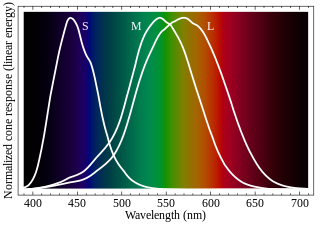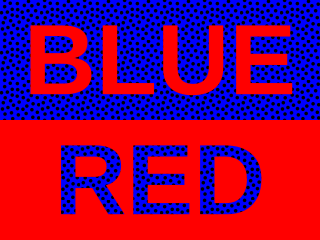
Color blindness or color vision deficiency (CVD) is the decreased ability to see color or differences in color. The severity of color blindness ranges from mostly unnoticeable to full absence of color perception. Color blindness is usually an inherited problem or variation in the functionality of one or more of the three classes of cone cells in the retina, which mediate color vision. The most common form is caused by a genetic condition called congenital red–green color blindness, which affects up to 1 in 12 males (8%) and 1 in 200 females (0.5%). The condition is more prevalent in males, because the opsin genes responsible are located on the X chromosome. Rarer genetic conditions causing color blindness include congenital blue–yellow color blindness, blue cone monochromacy, and achromatopsia. Color blindness can also result from physical or chemical damage to the eye, the optic nerve, parts of the brain, or from medication toxicity. Color vision also naturally degrades in old age.

The visible spectrum is the band of the electromagnetic spectrum that is visible to the human eye. Electromagnetic radiation in this range of wavelengths is called visible light. The optical spectrum is sometimes considered to be the same as the visible spectrum, but some authors define the term more broadly, to include the ultraviolet and infrared parts of the electromagnetic spectrum as well, known collectively as optical radiation.

In optics, chromatic aberration (CA), also called chromatic distortion and spherochromatism, is a failure of a lens to focus all colors to the same point. It is caused by dispersion: the refractive index of the lens elements varies with the wavelength of light. The refractive index of most transparent materials decreases with increasing wavelength. Since the focal length of a lens depends on the refractive index, this variation in refractive index affects focusing. Chromatic aberration manifests itself as "fringes" of color along boundaries that separate dark and bright parts of the image.

Sunglasses or sun glasses are a form of protective eyewear designed primarily to prevent bright sunlight and high-energy visible light from damaging or discomforting the eyes. They can sometimes also function as a visual aid, as variously termed spectacles or glasses exist, featuring lenses that are colored, polarized or darkened. In the early 20th century, they were also known as sun cheaters.

Stereoscopy is a technique for creating or enhancing the illusion of depth in an image by means of stereopsis for binocular vision. The word stereoscopy derives from Greek στερεός (stereos) 'firm, solid', and σκοπέω (skopeō) 'to look, to see'. Any stereoscopic image is called a stereogram. Originally, stereogram referred to a pair of stereo images which could be viewed using a stereoscope.
Achromatopsia, also known as Rod monochromacy, is a medical syndrome that exhibits symptoms relating to five conditions, most notably monochromacy. Historically, the name referred to monochromacy in general, but now typically refers only to an autosomal recessive congenital color vision condition. The term is also used to describe cerebral achromatopsia, though monochromacy is usually the only common symptom. The conditions include: monochromatic color blindness, poor visual acuity, and day-blindness. The syndrome is also present in an incomplete form that exhibits milder symptoms, including residual color vision. Achromatopsia is estimated to affect 1 in 30,000 live births worldwide.

Tetrachromacy is the condition of possessing four independent channels for conveying color information, or possessing four types of cone cell in the eye. Organisms with tetrachromacy are called tetrachromats.

Cone cells or cones are photoreceptor cells in the retinas of vertebrates' eyes. They respond differently to light of different wavelengths, and the combination of their responses is responsible for color vision. Cones function best in relatively bright light, called the photopic region, as opposed to rod cells, which work better in dim light, or the scotopic region. Cone cells are densely packed in the fovea centralis, a 0.3 mm diameter rod-free area with very thin, densely packed cones which quickly reduce in number towards the periphery of the retina. Conversely, they are absent from the optic disc, contributing to the blind spot. There are about six to seven million cones in a human eye, with the highest concentration being towards the macula.
Dichromacy is the state of having two types of functioning photoreceptors, called cone cells, in the eyes. Organisms with dichromacy are called dichromats. Dichromats require only two primary colors to be able to represent their visible gamut. By comparison, trichromats need three primary colors, and tetrachromats need four. Likewise, every color in a dichromat's gamut can be evoked with monochromatic light. By comparison, every color in a trichromat's gamut can be evoked with a combination of monochromatic light and white light.

Monochromacy is the ability of organisms to perceive only light intensity without respect to spectral composition. Organisms with monochromacy lack color vision and can only see in shades of grey ranging from black to white. Organisms with monochromacy are called monochromats. Many mammals, such as cetaceans, the owl monkey and the Australian sea lion are monochromats. In humans, monochromacy is one among several other symptoms of severe inherited or acquired diseases, including achromatopsia or blue cone monochromacy, together affecting about 1 in 30,000 people.

Cerebral achromatopsia is a type of color blindness caused by damage to the cerebral cortex of the brain, rather than abnormalities in the cells of the eye's retina. It is often confused with congenital achromatopsia but underlying physiological deficits of the disorders are completely distinct. A similar, but distinct, deficit called color agnosia exists in which a person has intact color perception but has deficits in color recognition, such as knowing which color they are looking at.

Chromostereopsis is a visual illusion whereby the impression of depth is conveyed in two-dimensional color images, usually of red–blue or red–green colors, but can also be perceived with red–grey or blue–grey images. Such illusions have been reported for over a century and have generally been attributed to some form of chromatic aberration.
The Farnsworth Lantern Test, or FALANT, is a color vision test originally developed specifically to screen sailors for tasks requiring color vision, such as identifying signal lights at night. It screens for red-green deficiencies, but not the much rarer blue color deficiency.
Gene therapy for color blindness is an experimental gene therapy of the human retina aiming to grant typical trichromatic color vision to individuals with congenital color blindness by introducing typical alleles for opsin genes. Animal testing for gene therapy began in 2007 with a 2009 breakthrough in squirrel monkeys suggesting an imminent gene therapy in humans. While the research into gene therapy for red-green colorblindness has lagged since then, successful human trials are ongoing for achromatopsia. Congenital color vision deficiency affects upwards of 200 million people in the world, which represents a large demand for this gene therapy.
Color blindness, also known as color vision deficiency, is a symptom that concerns diminished color vision and the decreased ability to see or distinguish colors.
Blue cone monochromacy (BCM) is an inherited eye disease that causes severe color blindness, poor visual acuity, nystagmus and photophobia due to the absence of functional red (L) and green (M) cone photoreceptor cells in the retina. BCM is a recessive X-linked disease and almost exclusively affects XY karyotypes.

EnChroma lenses are specialized glasses designed to address symptoms of red-green color blindness. Studies have shown that these lenses can alter the perception of colors that were already perceived, but they do not restore normal color vision.
A color vision test is used for measuring color vision against a standard. These tests are most often used to diagnose color vision deficiencies, though several of the standards are designed to categorize normal color vision into sub-levels. With the large prevalence of color vision deficiencies and the wide range of professions that restrict hiring the colorblind for safety or aesthetic reasons, clinical color vision standards must be designed to be fast and simple to implement. Color vision standards for academic use trade speed and simplicity for accuracy and precision.

Color tasks are tasks that involve the recognition of colors. Color tasks can be classified according to how the color is interpreted. Cole describes four categories of color tasks:

Congenital red–green color blindness is an inherited condition that is the root cause of the majority of cases of color blindness. It has no significant symptoms aside from its minor to moderate effect on color vision. It is caused by variation in the functionality of the red and/or green opsin proteins, which are the photosensitive pigment in the cone cells of the retina, which mediate color vision. Males are more likely to inherit red–green color blindness than females, because the genes for the relevant opsins are on the X chromosome. Screening for congenital red–green color blindness is typically performed with the Ishihara or similar color vision test. There is no cure for color blindness.


















